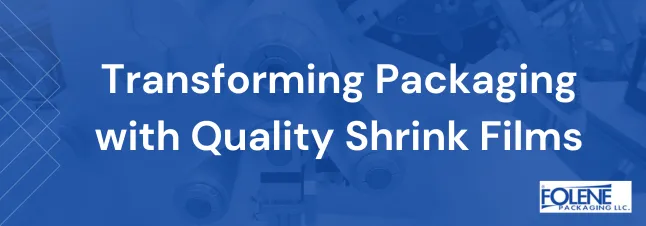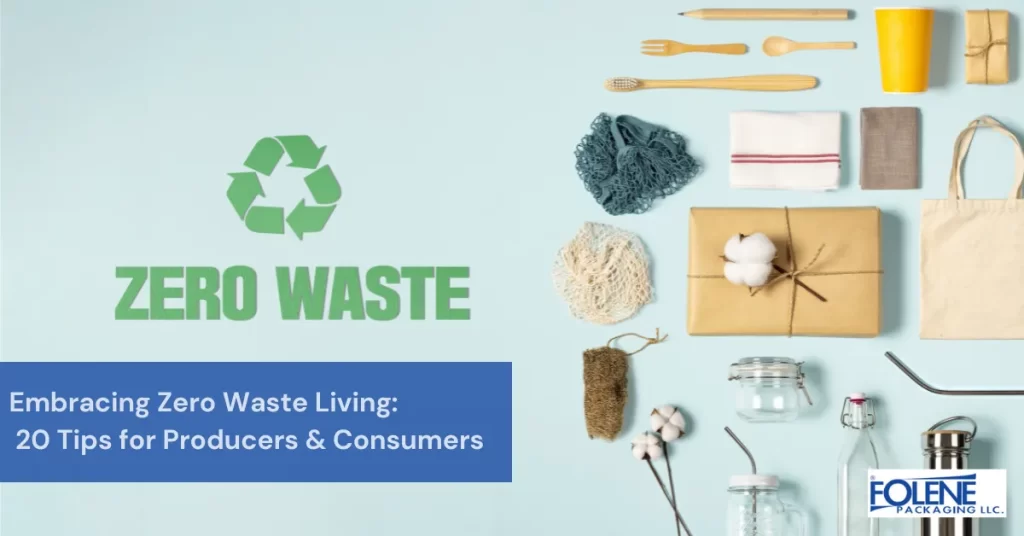
A major problem with adopting zero waste living is that we are too used to the linear model of use-to-refuse. Producers and consumers jointly contribute to this issue. Producers want to provide consumers with a top-quality product, which may include excess wrapping for a higher perceived value. Often, this encroaches on the producers’ responsibilities to the environment.
Consumers enjoy using new products; it’s that simple. It’s convenient to buy when the need arises. But throwing out worn or unwanted items and the packaging from new items generates mountains of waste. In the U.S., on average, each person contributes over 4.5 pounds of garbage daily, with around 275 million tonnes of plastic waste generated annually. What are we doing about this? Producers and consumers can make the most significant environmental impact by working towards a common goal and moving towards zero-waste living.
What is Zero Waste Living?
Zero-waste living refers to the goal of reducing waste to zero. In a zero waste lifestyle, waste is either not produced, is recycled for future use, or, is biodegraded into benign materials. Zero-waste living is about changing our habits to reduce waste, conserve raw materials, and live more sustainably.
What is zero waste management? The ZeroWaste organization points out several central foundations of zero-wasting:
Divert waste from landfills and reuse with an ultimate goal of zero waste to landfill
Focus on waste prevention as opposed to end-of-life waste management
Recycling is also an integral part of the zero-waste concept
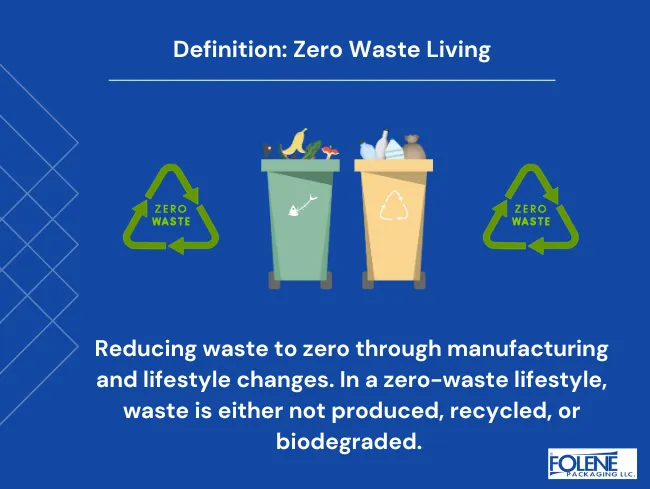
The Definition of Zero Waste
Zero waste is a “whole systems” approach focused on waste prevention. As such, it aims to reduce and eliminate the quantity and toxicity of waste we produce through more sustainable processes and designs on the manufacturers’ end and more mindful habits on the consumers’ end.
Manufacturers are working towards zero waste manufacturing, incorporating more zero waste packaging designs into their products and operations. Zero waste packaging examples include returnable glass milk and drink bottles, reusable shipping bags, and multiple-use packaging.
Who Oversees the Zero Waste Movement?
Since 2002, no effective federal plan has been in place to maximize recycling and minimize waste generation. ZeroWasteAmerica reports that waste treatment statistics have not changed much over the last 20 years since the U.S. Environmental Protection Agency (EPA) cannot collect or confirm accurate data.
Waste management in the U.S. has room to improve. This prompts concerned individuals to set the trend and establish unofficial or semi-official organizations that encourage a zero-waste lifestyle. Some of these are Zero Waste USA, the Zero Waste International Alliance (ZWIA), the Container Recycling Institute, Eco-Cycle, and the ZERI Institute.
A Zero Waste Lifestyle and Commerce
Zero waste can also create jobs as we learn to turn trash into treasure. There is less waste to landfill. We tap into local natural resources by supporting local farmers. We help them and ourselves—we buy fresh foods that are fresher. There is less transportation (read: less carbon emissions) and packaging of goods, making another aspect of business eco-friendly. Imagine you fill your natural fiber basket or reusable bag – we eliminate plastic bags, or at least most of them.
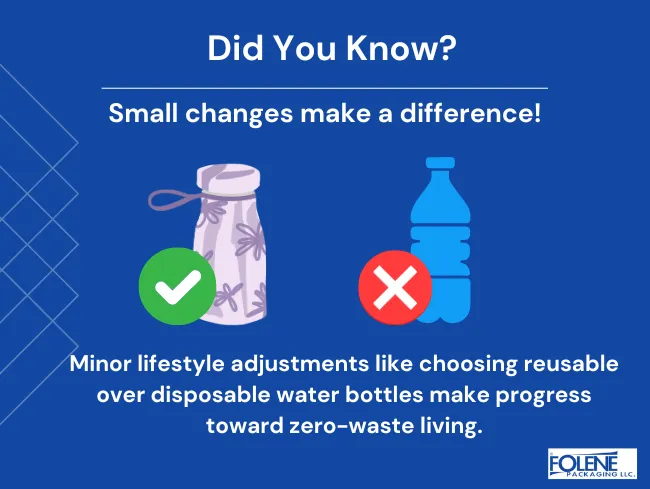
Zero Waste Lifestyle As A Concept
Zero waste living has existed since the 1980s when Daniel Knapp introduced the term ‘zero waste’ in his book Total Recycling.
By now, there are zero-waste communities. These are mainly for consumers.
Zero waste organizations, such as Green Business Certification Inc., offer help from TRUE zero waste advisors and train people to be TRUE advisors—recognized zero waste professionals.
A Zero Waste Journey
Zero waste is about being on a journey. The changes people will make will be gradual, not sudden. It’s about making small changes, producing as little waste and refuse as possible, and making progress.
Proponents of zero waste remind us that zero waste can look different for everyone; producers and consumers can contribute in various ways.
In addition to ‘saving the planet,’ by finding innovative ways to extend the useful life of our possessions, we will experience something special: valuing what we already have.
What Zero Waste Living Looks Like for Producers
What does zero waste mean for producers?
The EPA’s official zero waste definition is:
“Responsible production, consumption, reuse, and recovery of products, packaging, and materials without burning and with no discharges to land, water, or air that threaten the environment or human health.”
Going zero waste is an insurmountable challenge for many businesses and manufacturers – unless they are connected to supportive pro-environment agencies or motivated enough.
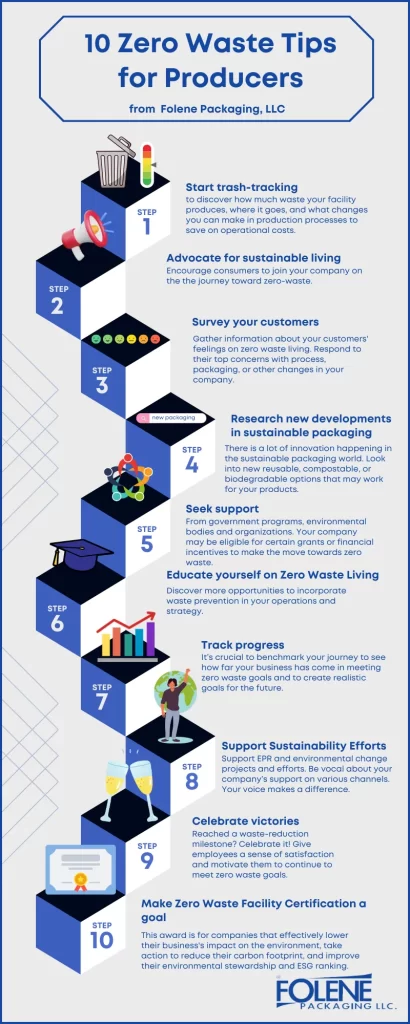
10 Zero Waste Lifestyle Tips for Producers
Producers welcome tips and ideas for moving towards a zero-waste lifestyle since a zero waste management definition is likely not enough to encourage practical application and actual results.
Here are 10 zero-waste manufacturing tips for producers to encourage zero waste:
Start trash-tracking to discover how much waste your facility produces, where it goes, and what changes you can make in production processes to save on operational costs.
Advocate for sustainable living; encourage consumers to join your company on the journey toward zero waste.
Survey your customers’ feelings about zero waste living and respond by changing packaging options. Saltwater Brewery changed how their beer cans were held together in response to consumer concerns over harming wildlife with traditional plastic rings. Instead of contributing to the 1,000,000 marine birds and 100,000 sea mammals and sea turtles that get trapped in beer rings from six-packs annually, they now use six-pack rings that are 100% biodegradable, and that can be safely eaten by marine animals that may encounter the refuse.
Research new developments in sustainable packaging for food and other items and read reputable lifestyle of zero waste reports such as those by McKinsey. Stay aware of updates in legal requirements.
Seek support from government programs and environmental organizations. The Sustainable Packaging Coalition supports companies and facilities in avoiding production that creates conditions for wasteful consumption or packaging that encourages waste.
Learn more about zero waste living. It is not just about producers reducing plastic in packaging; it’s also about opting for more sustainable processes that encourage waste reduction or avoiding fuel waste in shipping.
Support sustainability efforts through EPR and projects for social change. Producers can do this since they are closer to the start of the supply chain.
Track your facility’s progress. Tracking is essential if you want to continue with your project. Identify the business advantages of zero waste goals to highlight the motivation for going zero waste. Let your sustainability team and CSO (in-house or through an external supportive organization) lead your company in the right direction. Notice how you and the company save money through adopting a zero waste approach.
Celebrate your progress and accomplishments with the public. Publicity about improved corporate responsibility can generate loyalty to your brand among environmentally conscious consumers.
Let Zero Waste Facility Certification become a potential goal. This award is for companies that effectively lower their business’s impact on the environment, take action to reduce their carbon footprint, and improve their environmental stewardship and ESG ranking. To help you communicate how you reduce, recycle, and reuse your waste, the Scientific Certification Systems (SCS) Zero Waste Standard provides certification for business and commercial facilities that invest in waste diversion and reduction.
What Zero Waste Living Looks Like For Consumers
The Green City Times says consumers need to ’embrace’ zero waste living. This description indicates an emotional and moral impetus to switch to a more sustainable lifestyle. They state:
“Zero-waste living often involves making consumer choices with consciousness. Your choices can lead to financial savings. They can help you become more mindful of your purchases and consumption habits.”
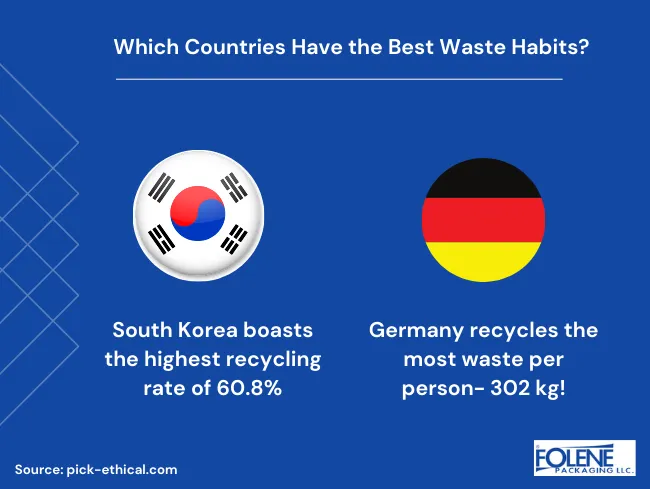
10 Zero Waste Lifestyle Tips for Consumers
Consumers should start with small, manageable changes rather than trying to achieve perfection in zero waste. They need to feel good about upgrading their ecological footprint—partially because change is hard to keep up with if it is unpleasant and partially because businesses still need consumers to buy products!
Here are 10 zero waste strategies tips for consumers to encourage zero waste:
Keep a trash chart. Try to reduce your daily waste by over 4 pounds, the average amount of trash an American generates.
Make sustainable choices by buying sustainable gifts, choosing products with minimal or no packaging, and selecting longer-lasting items. Find out if there is a bring-your-own-containers store near you.
Remember, every small step counts and even imperfect efforts can positively impact the environment. The feel-good factor means you will keep up your changes and maybe convince others to join you.
Increase your awareness. Look at what types of things you throw out to help identify areas where you can reduce waste. Make your habits zero waste habits.
Adopt strategies for reducing food waste. An effective way to do this with fresh produce is to buy only as much fresh food as needed. This way, less produce goes to waste and rots. Supermarkets enable this by prepackaging smaller amounts of produce for people living alone or in smaller families. Shrinkwrapping (with non-toxic, biodegradable shrink wrap) means the food looks appealing, and the wrapping helps it to stay fresher for longer – thus reducing the amounts of greenhouse gases released into the atmosphere.
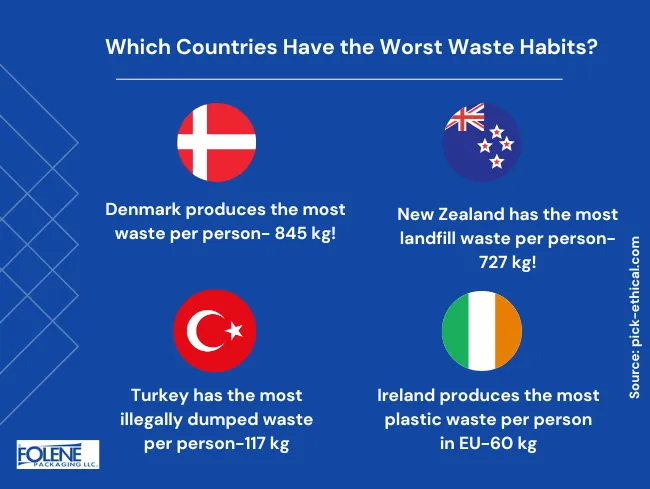
Select minor changes, such as reducing the use of throw-away plastic bottles, avoiding the use of single-use products when possible, and switching to reusable or cloth bags and water bottles.
Focus on areas where you’re most motivated to make a difference. Some people are more motivated by their food choices, others by their house-cleaning habits.
Investigate bulk shopping options for dry goods and other long-lasting products to reduce packaging waste.
Connect with others in a zero waste community and support vendors who share your values and goals.
Learn more by following a zero waste blog or reading official and unofficial reports. Seeing the statistics can help generate motivation.
Folene Packaging Recognizes How Shrink Wrap Can Contribute to Zero Waste Living
Folene Packaging recognizes its responsibility in the wider ‘green scene.’As a proud member of the Sustainable Packaging Coalition, we are committed to delivering sustainable packaging solutions primarily to producers and, secondarily, to consumers as we help companies reduce waste in packaging.
Folene Packaging offers two grades of Ecolene® shrink film, both of which are 100% biodegradable within 9 months to 5 years, and support producer and consumer obligations for waste disposal. Our newest grade of shrink film, Ecolene® AP-XPCR, is made primarily from post consumer content, is fully biodegradable, and possesses the strength and characteristics of traditional cross-linked shrink film. In addition, Folene Packaging’s range of Flxtite® uncrosslinked films is fully recyclable.
Folene Packaging shrink wrap comes in various widths and thicknesses, enabling you to apply efficiency and waste less.
Reach out to Folene Packaging today to learn more about how Folene Packaging supports zero-waste living with sustainable packaging solutions.
Zero Waste Living FAQs
Does recycling as it stands in the U.S. support a zero waste lifestyle?
Recycling in the U.S. falls short of global recycling goals. The EPA reports that in 2018 (the most recent government figures), the total recycled municipal trash in the US was more than 69 million tonnes. What was recycled? Plastic packaging was only 4.47% of the total amount recycled (about 3 million tonnes), the same amount as glass – and we use a lot more plastic than glass.
